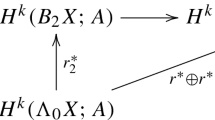Abstract
In the present paper, we obtain explicit formulae for geodesics in some left–invariant sub–Finsler problems on Heisenberg groups \(\mathbb {H}_{2n+1}\). Our main assumption is the following: the compact convex set of unit velocities at identity admits a generalization of spherical coordinates. This includes convex hulls and sums of coordinate 2–dimensional sets, all left–invariant sub–Riemannian structures on \(\mathbb {H}_{2n+1}\), and unit balls in Lp–metric for \(1\le p\le \infty \). In the last case, extremals are obtained in terms of incomplete Euler integral of the first kind.







Similar content being viewed by others
Notes
Obviously, for any 𝜃, there exists an angle 𝜃∘ such that \(\theta ^{\circ }\leftrightarrow {{\varOmega }^{\circ }}\theta \). This can be easily proved by the hyperplane separation theorem.
The angle 𝜃 is defined up to \(2\mathbb {S}\mathbb {Z}\) as always.
I.e., a solution to PMP projection on the base \(\mathbb {H}_{2n+1}\).
Obviously, hi, gi, and γ are linear on fibers left–invariant coordinates on \(T^{*}\mathbb {H}_{2n+1}\).
References
Agrachev A, Barilari D, Boscain U. 2019. A comprehensive introduction to sub-Riemannian geometry. Cambridge studies in advanced mathematics Cambridge University Press.
Agrachev A, Sachkov Y. 2004. Control theory from the geometric viewpoint encyclopaedia of mathematical sciences.
Ardentov A, Lokutsievskiy L, Sachkov Y. 2020. Explicit solutions for a series of classical optimization problems with 2-dimensional control via convex trigonometry, arXiv:2004.10194v1.
Balogh ZM, Calogero A. 2019. Infinite geodesics of sub-Finsler distances in Heisenberg groups. International mathematics research notices.
Berestovskii V. Geodesics of nonholonomic left-invariant intrinsic metrics on the Heisenberg group and isoperimetric curves on the Minkowski plane. Sib Math J 1994;35(1):1–8. https://doi.org/10.1007/BF02104943.
Berestovskii V N. Homogeneous manifolds with intrinsic metric. i. Sib Math J 1988;29(6):887–897. https://doi.org/10.1007/BF00972413.
Biggs R, Nagy PT. A classification of sub-Riemannian structures on the Heisenberg groups. ACTA POLYTECH HUNG 2013;10(7):41–52. https://doi.org/10.12700/APH.10.07.2013.7.4.
Brockett R, Dai L. 1993. Nonholonomic motion planning, chap. Non-holonomic kinematics and the role of elliptic functions in constructive controllability, pp 1–21.
Busemann H. The isoperimetric problem in the Minkowski plane. Am J Math 1947;69(4):863–871. https://doi.org/10.2307/2371807.
Filippov A. 1988. Differential equations with discontinuous righthand sides. Kluwer.
Freeman D, Le Donne E. 2018. Toward a quasi-möbius characterization of invertible homogeneous metric spaces.
Gaveau B. Principe de moindre action, propagation de la chaleur et estimees sous elliptiques sur certains groupes nilpotents. Acta Math 1977;139:95–153. https://doi.org/10.1007/BF02392235.
Gromov M. Groups of polynomial growth and expanding maps (with an appendix by jacques tits). Publications Mathématiques de l’IHÉS 1981;53:53–78.
Huybrechts D. 2005. Complex geometry, an introduction universitext.
Le Donne E. 2013. A metric characterization of carnot groups. pp 845–849.
Lokutsievskiy L. Convex trigonometry with applications to sub-Finsler geometry. SB MATH 2019;210(8):120–148. https://doi.org/10.1070/SM9134.
Magaril-Il’yaev G, Tikhomirov V. 2003. Convex analysis: theory and applications. amer mathematical society.
Rockafellar R. Convex analysis. Princeton: Princeton University Press; 1997.
Shelupsky D. A generalization of the trigonometric functions. Am Math Mon 1959;66(10):879–884. https://doi.org/10.1080/00029890.1959.11989425.
Vershik A, Gershkovich V. Nonholonomic dynamical systems. geometry of distributions and variational problems. Dynamical systems — 7. Itogi Nauki i Tekhniki. Ser Sovrem Probl Mat Fund Napr 1987;16:5–85.
Wei D, Liu Y, Elgindi MB. Some generalized trigonometric sine functions and their applications. Appl Math Sci 2012;6(122):6053–6068.
Acknowledgments
The author would like to express his deep gratitude to Professor A.I. Nazarov for interesting discussions and pointing on a connection to Shelupsky’s functions.
Funding
This work is supported by the Russian Science Foundation under grant 20-11-20169.
Author information
Authors and Affiliations
Corresponding author
Additional information
Publisher’s Note
Springer Nature remains neutral with regard to jurisdictional claims in published maps and institutional affiliations.
Rights and permissions
About this article
Cite this article
Lokutsievskiy, L.V. Explicit Formulae for Geodesics in Left–Invariant Sub–Finsler Problems on Heisenberg Groups via Convex Trigonometry. J Dyn Control Syst 27, 661–681 (2021). https://doi.org/10.1007/s10883-020-09516-z
Received:
Revised:
Accepted:
Published:
Issue Date:
DOI: https://doi.org/10.1007/s10883-020-09516-z



